Blood Type O Lowers Myeloma Risk, But Outcomes Typically Worse
Written by |

People with blood type O are significantly less likely to develop multiple myeloma, but those who do are likely to have more aggressive disease and poorer survival outcomes, a study found.
The study, “Effect of the ABO blood groups on the development, clinical features and survival of multiple myeloma,” was published in the journal Magazine of European Medical Oncology.
ABO blood groups are based on different carbohydrates on the surface of red blood cells, and their distribution may vary depending on ethnicity, geographical location, and socioeconomic group. These same carbohydrates are also found on various other tissues, including nerve cells, platelets, cells that line blood vessels, and other body fluids.
Evidence suggests that ABO blood groups may play a role in the development of many diseases, including cancers of the digestive system, and white blood cell cancers such as leukemia and lymphoma. However, the impact of ABO blood groups on the development of multiple myeloma is unclear.
Researchers at the Antalya Training and Research Hospital in Turkey examined the medical records of 198 people diagnosed with multiple myeloma, whose blood types were known.
The analysis included 92 women and 106 men, with a median age of 63. Of them, 46.5% had blood type A, 24.7% had type O, 19.2% were in blood type B group, and 9.6% had type AB.
For comparison, a control group of 23,558 individuals attending this hospital clinic but without any form of cancer was also included. Here, 41.1% had blood type A, 36.4% had type O, 15.8% were in the blood type B group, and 6.8% had type AB.
Participants with blood type O were found to be significantly less likely to develop multiple myeloma than the other groups, with a relative risk reduction of 42.5%.
Researchers then examined differences in clinical and other outcomes among these patient groups. The groups were overall very similar in terms of gender distribution and median age at the time of diagnosis.
However, heavy chain and light chain immunoglobulins, which are multiple myeloma biomarkers, were more common in patients with blood type A, while the prognostic marker lactate dehydrogenase (LDH) level was significantly higher in type 0 compared with other types.
Notably, while all groups were very similar for most signs of myeloma — renal failure, anemia, bone lesions, and elevated calcium — patients in group O had a significantly higher incidence of extramedullary lesions.
These lesions occur when myeloma cells form tumors outside the bone marrow, in the soft tissues or organs of the body, and are typically associated with resistance to treatment and poor prognosis.
In line with that finding, patients with a blood type O also had a significantly shorter survival than those in other groups. A statistical analysis found other factors that were significantly associated with survival, including age and LDH levels.
“In conclusion, individuals with blood group 0 had a lower risk of developing MM [multiple myeloma],” the investigators wrote. However, “having blood group 0 was a very important prognostic factor for MM patients and was associated with short OS [overall survival].
“Although there was a relationship between ABO blood group system and the development of MM and OS, additional studies are needed to explain the mechanism of this relationship,” they added.






